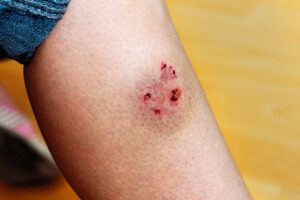Many people have been told that dogs’ mouths are cleaner than a human’s mouth, but this is a myth! Dogs’ mouths contain just as many bacteria as our own. Most of these bacteria are specific to dogs, meaning that they prefer to colonize the canine species and not humans. But there are some bacteria in a dog’s mouth that can cause infections in humans if given the right opportunity.
One of the perfect opportunities for infection is when a dog bites a human hard enough to break the skin – a protective barrier that usually prevents bacteria from entering the body. A break in the skin – like that caused by a dog’s teeth – allows bacteria to enter the body and potentially cause an infection. It’s important to treat dog bites properly to prevent infection; see “First Aid for Dog Bites,” below.
Follow these steps if you are bitten by a dog:
- Wash the wound thoroughly with soap and warm water.
- Apply an antibiotic ointment or cream and cover the wound with a clean bandage.
- Check the wound at least twice a day. Signs of infection include redness, swelling, discharge, increased pain, or foul odor. If you notice any of these signs, seek medical attention immediately.
Seek medical attention immediately if:
- The wound is deep or the skin is crushed or torn.
- The wound is bleeding significantly.
- You are unsure of the rabies vaccination status of the dog who bit you.
- You have not had a tetanus vaccine in more than 10 years (5 years if the wound is dirty).
If you are not sure about the seriousness of your wound, don’t take chances; consult with your healthcare professional.
The top three bacterial species found in infected dog bite wounds are Pasteurella, Streptococcus, and Staphylococcus. Other common bacterial species isolated from infected dog bite wounds include Neisseria, Corynebacterium, Fusobacterium, and Porphyromonas.
Another opportunistic bacteria found in the mouths of dogs and humans is Capnocytophaga. According to the Centers for Disease Control (CDC), Capnocytophaga from a dog’s mouth does not typically cause infections in people, even in bite wounds. However, people with compromised immune systems or who are pregnant, very young (less than 5 years of age), or seniors (65 years of age or older) are at increased risk of developing an infection from Capnocytophaga. Individuals at increased risk of developing an infection from Capnocytophaga should not allow their dog to lick them. Small breaks in the skin (such as cuts or other wounds) can allow bacteria to enter the body. Allowing dog saliva to have contact with an at-risk individual’s mouth, nose, or eyes can also increase the risk of infection from Capnocytophaga. For more information about this infection, see the CDC’s page on Capnocytophaga.
Dogs who consume a raw food diet pose an additional risk if they are allowed to lick their humans. Raw food is more likely to be contaminated with the bacteria Salmonella, Escherichia coli, or Listeria monocytogenes.These bacteria can reside in the mouths of dogs who consume raw food. Dogs may inadvertently spread bacteria from raw food to their humans through the simple act of licking their faces.
So, let’s bust that myth about dog mouth cleanliness! Dogs’ mouths are just as dirty and full of bacteria as the mouths of humans. But for most people (and their dogs!) being licked by their dog should not be a major issue.






